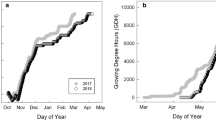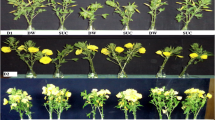Abstract
Key message
The gynoecium in M. denudata was thermogenic, and the first peak in the female phase lasted longer than the second peak in the male phase during flowering.
Abstract
The floral biology of Magnolia denudata, including the thermogenesis of floral buds and blooming, were investigated using a portable infrared thermal imaging radiometer and digital infrared thermometer. We found that M. denudata buds have extremely dense trichomes that maintain internal temperatures above external temperatures. The pattern of thermogenesis in M. denudata anthesis consisted of two distinct episodes corresponding to apparent receptivity of the stigmas in the female phase and incipient shedding of pollen in the male phase: one begins in the female phase and lasts about 6 h and another occurs synchronously 24 h later and lasts about 4 h in the male phase. In addition, we found that the temperature was significantly elevated in the inner petals upon flowering, indicating that they may play an important role in producing a warm floral chamber. These results increase our understanding of the strategies used by Magnoliaceae blossoms to maintain an optimal microclimate at low temperatures in the early spring.





Similar content being viewed by others
References
Barthlott W, Szarzynski J, Vlek P, Lobin W, Korotkova N (2008) A torch on the rain forest: thermogenesis of the Titan Arun (Amorphophallus titanium). Plant Biol 11:499–505
Corbet SA (1990) Pollination and the weather. Isr J Bot 39:13–20
Dieringer G, Cabrera RL, Lara M, Loya L, Reyes-Castillo P (1999) Beetle pollination and floral thermogenicity in Magnolia tamaulipana (Magniliaceae). Int J Plant Sci 160:64–71
Endress PK (1994) Diversity and evolutionary biology of tropical flowers. Cambrid University Press, Cambridge, pp 25–30
Gottsberger G, Gottsberger IS, Seymour RS, Dötterl S (2012) Pollination ecology of Magnolia ovata may explain the overall large flower size of the genus. Flora 207:107–118
Grant NM, Miller RE, Walting JR (2008) Synchronicity of thermogenic activity, alternative pathway respiratory flux, AOX protein content, and carbohydrates in receptacle tissues of sacred lotus airing floral development. J Exp Bot 59:705–714
Hedhly A, Hormaza J, Herrero M (2008) Global warming and sexual plant reproduction. Trends Plant Sci 14:30–36
Kumano-Nomura Y, Yamaoka R (2009) Beetle visitations, and associations with quantitative variation of attractants in floral odors of Homalomena propinqua (Araceae). J Plant Res 122:183–192
Lamprecht L, Schomolz E, Blanco L, Romero CM (2002) Flower ovens: thermal investigations on heat producing plants. Thermochim Acta 391(1–2):107–113
Lu S, Rieger M, Duemmel MJ (1992) Flower orientation influences ovary temperature during frost in peach. Agric Forest Meteorol 60:181–191
Luo SX, Chaw SM, Zhang DX, Renner SS (2010) Flower heating following anthesis and the evolution of gall midge pollination in Schisandraceae. Am J Bot 97:1220–1228
Miller RE, Walting JR, Robinson SA (2009) Functional transition in the floral receptacle of the sacred lotus (Nelumbo nucifera): from thermogenesis to photosynthesis. Funct Plant Biol 36:471–480
Miller RE, Grant NM, Giles L, Ribas-Carbo M, Berry JR et al (2011) In the heat of the night–alternative pathway respiration drives thermogenesis in Philodendron bipinnatifidum. New Phytol 189:1013–1026
Seymour RS, Schultze-Motel P (1998) Physiological temperature regulation by flowers of the sacred lotus. Philos T R Soc B 353:935–943
Seymour RS, White CR, Gibernau M (2003) Heat reward for insect pollinators. Nature 426:243–244
Seymour RS, Gibernau M, Pirintsos SA (2009a) Thermogenesis of three species of Arun from Crete. Plant Cell Environ 32:1467–1476
Seymour RS, Ito Y, Onda Y, Ito K (2009b) Effects of floral thermogenesis on pollen function in Asian skunk cabbage Symplocarpus renifolius. Biol Lett 5:568–570
Seymour RS, Gottsberger IS, Gottsberger G (2010) Respiration and temperature patterns in thermogenic flowers of Magnolia ovata under natural conditions in Brazil. Funct Plant Biol 37:870–878
Thien LB, Azuma H, Kawano S (2000) New perspectives on the pollination biology of basal angiosperms. Int J Plant Sci 161:225–235
Thien LB, Bernhardt P, Devall MS, Chen ZD, Luo YB et al (2009) Pollination biology of basal angiosperms (ANITA grade). Am J Bot 96:166–182
Thomas A, Graziano R, Rodolfo G (2012) Response of alpine plant flower production to temperature and snow cover fluctuation at the species range boundary. Plant Ecol 1:1–13
Tsukaya H, Tsuge T (2001) Morphological adaptation of inflorescences in plants that develop at low temperatures in early spring: the convergent evolution of “downy plants”. Plant Biol 3:536–543
Wang RH, Jia H, Wang JZ, Zhang ZX (2010) Flowering and pollination patterns of Magnolia denudata with emphasis on anatomical changes in ovule and seed development. Flora 205(4):259–265
Watling JR, Robinson SA, Seymour RS (2006) Contribution of the alternative pathway to respiration during thermogenesis in flowers of the Sacred Lotus. Plant Physiol 140(4):1367–1373
Acknowledgments
This work was supported by the Fundamental Research Funds for Central Universities (No. HJ2010-23), National Science Fund of China (No. 31100450), National Science Fund of China (No. J1103516). We are grateful to RTKB Technology Co., Ltd for the use of their thermographic imaging equipment.
Author information
Authors and Affiliations
Corresponding author
Additional information
Communicated by J. Lin.
Rights and permissions
About this article
Cite this article
Wang, R., Liu, X., Mou, S. et al. Temperature regulation of floral buds and floral thermogenicity in Magnolia denudata (Magnoliaceae). Trees 27, 1755–1762 (2013). https://doi.org/10.1007/s00468-013-0921-x
Received:
Revised:
Accepted:
Published:
Issue Date:
DOI: https://doi.org/10.1007/s00468-013-0921-x




